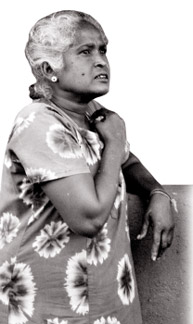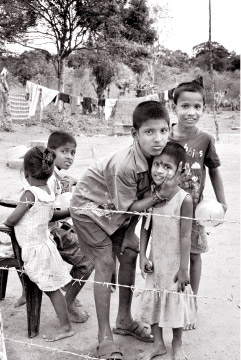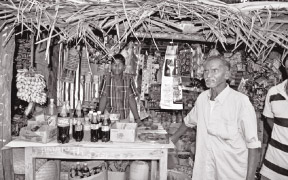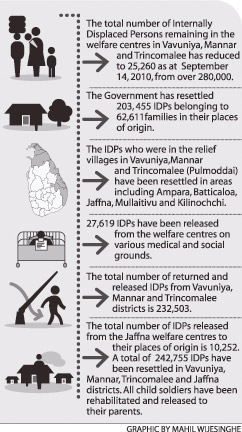|
Normalcy returns to Northern villages:
Rising from the ashes
By Sahanika SRIYANANDA reporting from Vavuniya
|

Aiiyadorai Gunawathi
|
True peace has now dawned in the Northern region after many years.
With no deadly sounds of firing or explosions or abductions, the
villagers of Vellankulam, 40 km off Vavuniya, are planning their future.
After a brief spell of rain, the fertile land has turned more green with
fresh leaves popping out.
 |
|
Children now live without
fear |
Still facing a water scarcity, the villagers thanked the soldiers for
cleaning the abandoned well. Aiiyadorai Gunawathi (60) was drawing water
from the well when we stopped at her doorstep.
The villagers fled Vellankulam in end-2008 and the LTTE herded them
like cattle. Gunawathi, though physically not fit to run, moved with the
rest of the villagers from place to place.
The villagers carried their household items in tractors, motorcycles
and bicycles the day they stepped out of their village on orders from
the LTTE. They continued to run each time soldiers captured an LTTE-dominated
area. The number of goods that they carried dwindled and at last they
possessed only the IDs and a few certificates to prove that they were
citizens of Sri Lanka.
Gunawathi’s last destination in the harrowing journey was
Ammpalanpokkanei, where the LTTE kept thousands of civilians as a human
shield to get international sympathy to stop the military push, last
year.
Her only son, who is married, lives in Varani, Jaffna. Undergoing
many hardships including starvation, the villagers fled LTTE control and
ran for safety towards the Army.
Those bitter memories are now fading away with the infusion of a new
lease of life. Twenty eight families have returned to the village from
the Chettikulam welfare centre. Instead of their damaged houses, they
have now got small wattle and daub houses.
We crept into the small house. There were no chairs to sit. Gunawathi
humbly invited us to sit on the mat woven of palm leaves. A bag of
clothes was hung on the wall. An oil lamp was lit for God Shiva.
Gunawathi boiled water to make tea while relating to us her story of
those days when they were in the grip of the LTTE.
Her small kitchen had some stocks of essential food items given by
the Government as rations to resettled villagers.
“We thank the soldiers for helping us to build these houses”, she
said.
The newly-built houses give the village a fresh look. Yet, with no
colour washing, the row of houses reminded us of an eco-friendly tourist
resort.
Fed by the Government

K. Kailanathan |

Anandaraja at his stall |
Subramanium Lechchami (58) was Gunawathi’s neighbour. Her daughter,
Lakshmi, who is a widow and mother of three grown-up girls, owns the
village’s only boutique.
Though the villagers resettled here after an year-long stay in the
Chettikulam Welfare Centre, they are still fed by the Government. A
small plot of land has been turned into a home garden with vegetables
and fruits. Earlier, they grew tobacco, but abandoned the cultivation
due to water scarcity. The Army has now promised them to find sponsors
for water pumps.
“There is good demand for rice. I sell essentials worth Rs. 1,000
daily”, Lakshmi said. Her three daughters continue their studies at the
Nedunkerni Tamil Maha Vidyalaya.
They said the LTTE ordered them to run, saying the Sinhalese soldiers
were coming and killing people. Lechchami, Lakshmi and her family ended
their deadly journey at Pokkanei and were lucky enough to get the help
of the Sri Lanka Navy, which shipped them to safety.
The Nedunkerni town, a strategic location for the LTTE for several
years, fell into Army hands on December 20, 2008. The few
severely-damaged and bullet-ridden buildings which remain among the
buildings coming up are showpieces of the battle that captured
Nedunkerni. It had an LTTE ‘police’ station and a prison operated by the
LTTE’s intelligence unit.
Today, it is yet another busy township where business booms and lives
are returning to normal with more displaced people returning home.
In the makeshift boutique, teenager Anandaraja sells everything, from
vegetables to essential food items to soft drinks to chocolates. Though
they are not chilled, the soft drinks have a fairly good demand.
Small business
Anandaraja re-started schooling after they returned to Kulavisuddan
village from the welfare centre nine months ago. With Rs. 25,000, the
money granted by the Government for the refugees, his mother has started
a small business in the town.
His mother became the breadwinner of the family after his father was
shot dead by the LTTE, which started firing when the family together
with thousands of displaced civilians fled Puthumathalan, a few weeks
before the military defeated the LTTE.
Being a Grade 10 student, Anandaraja looks after the business while
his mother attends to housework and takes his two younger sisters and
brother to tuition classes. With the Nedunkerni Tamil School returning
to normal with new teachers arriving and facilities for children
improving with the assistance of the Army, private tuition classes have
started, especially to help children catch up with the lessons they had
missed.
The teenager recalled how his mother hid him from the LTTE, which
came on several occasions to recruit him as a child soldier.
“We ran from place to place and lived in huts. Some died of snake
bites. They came to take me and some other boys, but my mother kept me
hidden.
|

The Sinhala villege of Kokeliya |
She told the LTTE police that I was missing while I remained in a
hole dug near the hut.
Each time we ran away, my mother did that. It was difficult to live
there as it was hot during the day time. Some times I thought I would
die as I could not breathe”, he said. The happy and proud mood of the
boy changed and tears glistened in his eyes.
But he kept on relating his experiences. Life for him and thousands
of other children was dangerous after they reached Puthukudiyiruppu and
then Puthumathalan, where the Government had declared two No Fire Zones
(NFZ). Civilians on the run expected relief, but the LTTE had made the
NFZ its battle pad with their heavy weapons fixed amidst the civilian
population.
“Now, I can’t even imagine how we suffered two years ago. I don’t
want to suffer like that again”, the boy said.
With soldiers moving around frequently, talking to them in a friendly
tone, helping them in their day-to-day activities and guarding their
townships and villages from dawn to dusk, the young Northern generation
is now in touch with these souls whom the LTTE had described to them as
evil.
Anandaraja hopes his mother will secure a place in the new market
that is being built for the first time in the Nedunkerni town. A Co-op
Shop is the latest attraction in the town. A new bus-stand is under
construction and the Divisional Hospital of Nedunkerni functions well
with a crowded OPD with 75 patients and five deliveries being performed
daily.
For the first time, the town is connected to the national grid and
the hospital which is currently running on generator power will be given
priority.
The majority of villagers being farmers, they have reaped a high
yield in tobacco, vegetables - brinjal, chilies, pumpkin - and fruits
from the fertile soil which is similar to that of Nuwara Eliya. They
sell the products at the market in the town and also to traders that
come from Vavuniya and Anuradhapura. The farmers have been given water
pumps by several NGOs, through the Army.
Nedunkerni Tamil Maha Vidyalaya, which has 370 students, has got a
‘Happiness Centre’ and a psychotherapy centre, funded by the Army for
the primary section. After many years, the map of Sri Lanka now adorns
the school walls. Instead of a Tiger with a T-56 drawn out and the map
of Sri Lanka with LTTE-dominated areas in red, to motivate
schoolchildren to join the outfit, a picture of a teacher dancing with
small schoolchildren is now displayed.
The Centre has toys, books, sports equipment for cricket, chess and
badminton and musical equipment. The small children who were used to
scenes of flesh and blood, and crying in fear when they were caught up
in a deadly war, are now learning life through dancing, music and
playing.
Major Anura Illangakoon, Commanding Officer of the 17th VIR, said
that from the initial stages of the resettlement program, the soldiers
helped the villagers and this gradual assistance grew to a strong bond
between them and the Army.
Dry rations
“Though the Government provided these villagers with dry rations for
the first three months after resettlement, the Army gave them cooked
meals, and then helped them build their houses, clear the land for
cultivation, and guarded their villagers. Now they want us to help them
restore their livelihoods”, he said.
Resettled in Kulavisuddan, a village eight km off Vellankulam, the
villagers have started cultivating vegetables and selling them in the
Nedunkerni market.
Seventy-year-old Kaneshavari, who cultivated tobacco earlier, is
growing vegetables as they have a good demand.
She has to feed her two young daughters and also her eldest daughter
who had been given in marriage in her teens to prevent her from being
forcibly taken away by the LTTE. Today, the old mother is saddled with
extra responsibilities as she is compelled to feed two grandchildren.
Her daughters who missed schooling for over two years are now doing
their Advanced Levels at Nedunkerni Tamil Maha Vidyalaya.
Kaneshavari, who is sick of being trampled under the LTTE’s boot,
prays to the Gods to not make them suffer.
“We had to pay a tax of five percent from each kilo of vegetables or
any thing we sell, to the LTTE. We did not want to go with the LTTE, but
they started assaulting us when we refused to go with them. The males
and young boys and girls were abducted by the LTTE. The parents who
refused to give their children away were badly beaten and left in
prisons”, the woman who fled Puthumathalan during the last days of the
conflict said.
She said that the LTTE never helped the villagers and even the food
and other items sent by the Government were used by the LTTE and
distributed among their loyalists. None of the villagers had proper
houses, but they lived in huts which were like cowsheds while the LTTE
leaders enjoyed luxurious lives.
“The LTTE spread false propaganda that they were helping the
Mahaveera families. When a cadre died, the family got Rs. 5,000 and that
was all. When we were in Puthumathalan, the LTTE attacked the Army using
heavy weapons fixed among us. They shot at us when we tried to flee.
“The LTTE ordered every one to join them to fight, but people refused
and prayed that the Army would save them”, Kaneshavari said.
She still curses the LTTE and Prabhakaran for making the Tamils
suffer. She does not want the LTTE to raise its head again.
“We want soldiers to be with us. When they are here we know the LTTE
cannot come back. We want to save our children and provide a good future
for them. Today, even in the middle of the night, we can be out on the
road as the Army is there to protect us. Those days, after 6 pm, we were
in bunkers”, she recalled.
The Army which had set up camps in private buildings and other areas,
are gradually vacating them, following the instructions of Defence
Secretary Gotabaya Rajapaksa. The Thandikulam Army Camp, which had
occupied over 10 acres of private land, was handed over to the original
land owners, in July.
K. Kailanathan (68), a former employee of the Ceramic Corporation,
was busy clearing his three-quarter acre land which had debris from the
Army camp along the A-9 road. “It’s very difficult to find a labourer
and it’s also costly”, he said.
 Happy
that the Army has returned his land, Kailanathan, who was clad in a
verti, the traditional dress worn by Tamils, said he stayed with
relatives after his land was taken over by the Army in 1990. Happy
that the Army has returned his land, Kailanathan, who was clad in a
verti, the traditional dress worn by Tamils, said he stayed with
relatives after his land was taken over by the Army in 1990.
Store room
His five-room house with a big store room which could stock over
1,000 bags of paddy was completely destroyed by the crossfire in 1997.
Being a farmer who owned 23 acres of paddy land, Kailanathan said
that he could not build the house as he is now old and weak.
“Tamils became poor due to the LTTE and lost everything. With no
education, it will take ages to produce educated Tamils as the present
young generation lost the opportunity for education due to the 30-year
war”, he said.
Kailanathan said though they very well know that the LTTE is no more,
they get nervous even when they hear a tyre puncture.
He said people were happy as normalcy had returned and the A-9 road
had become a busy highway with hundreds of vehicles using it daily.
After the military silenced the LTTE’s guns, the villagers of the
175-year-old Sinhala village - Kokeliya - have returned to their homes
which they had left in 1985.
Kokeliya is the only Sinhala village in the area and was always
targeted for LTTE attacks. Since the 1980s, the LTTE abducted and shot
dead many villagers to make them run away from the village.
Nine prominent village personalities, including the chief-incumbent
of the village temple, Grama Sevaka and schoolteachers, who tried to
save the village, went missing forever. The LTTE set fire to the
Kokeliya village one night and bombed some houses.
Unable to face the LTTE terror, the entire village - 980 people -
fled and sought refuge in camps in Senapura and Nochchiyagama while some
went to their relatives. Some families returned to the village in 1992
and 2002, but again abandoned the village as the LTTE started harassing
them again.
“We came here in January this year and on the instructions of Brig.
Napagoda, the soldiers are helping us to build our houses, clean wells
and schools and clear abandoned paddy land. As we are now 100 percent
sure that the LTTE will not come back, we want to develop this village”,
Sunil Gamini said.
He recalled the days where they, as young children, crept into the
forest to sleep in a hole dug for their safety. “ The LTTE, who came to
the village in the middle of the night, massacred many families and set
fire to their houses”, he said.
Ajith Priyashantha, an ex-sailor who ran away from the village when
he was 16, said his father and seven others were abducted by the LTTE.
They are still missing.
“As we were displaced several times, we missed our education. The
LTTE killed our family members. The damage the LTTE did to us is
enormous”, he said.
The villagers of Kokeliya want to develop the village to provide a
better future for their children who are now schooling. People from the
adjoining Tamil village, who too have been recently resettled, helped
the villagers of Kokeliya to clear the roads and cultivation and in turn
the villagers of Kokeliya helped the Tamil villagers in their work. Both
communities now have one desire - “Don’t let the LTTE raise its head”.
Reconciliation among the two communities, the missing ingredient in
strengthening relations, has naturally begun with new found peace after
the annihilation of the 30-year curse - LTTE terrorism.
I recalled Gunawathi’s kind invitation. “Vanthu Irukkavum. Tea
Kudikkavum” (Come and have a seat. Have a cup of tea). The lost link
between the two communities is re-emerging. The hatred created by LTTE
terrorism is gradually fading away. Despite the communication barriers,
facial expressions denoting happiness and kindness have helped bridge
the gap between them to renew their ties.
***********
A helping hand from the soldiers
|

Brigadier Priyantha Napagoda
|
Brigadier Priyantha Napagoda, the General Officer Commanding of the
56 Division, said resettlement is nearing completion in many areas of
Vavuniya. Soldiers helped the villagers to construct houses, clear
abandoned land for cultivation, clean wells, repair schools and
hospitals and remove earth bunds built by the LTTE .
“In most villages, there are many widows while some men are in
rehabilitation centres. The soldiers helped them construct their houses.
There are three Army units in charge of these activities and they build
10 houses every month”, he said.
Brig. Napagoda said villagers want the soldiers to remain in their
village to provide security though the Army was gradually vacating
private premises.
Several medical clinics have been held with the help of local and
foreign doctors. The villagers who mainly depend on agriculture are
waiting for the rains so that they can commence farming. He said the
change in these people is obvious from their physical appearance. “We
noticed their appearance and behaviour when they initially came to us.
Nobody was laughing and they looked at the Army officers with suspicion.
They had doubts about the soldiers as they were thoroughly brain washed
by the LTTE for over three decades”, Brig. Napagoda said.
The 56 GOC said after ending the conflict the Army had delivered the
message among the villagers that the Government needed their support to
re- build their villages and also to re-build a new Sri Lanka. “We told
them that the Army would not leave room for the LTTE to make a comeback
and needed their support. We requested them to give information which
could protect them. During this short period, we have built trust and
given them confidence that they can rise from the debris of the 30-year
curse”, he said.
According to Brig. Napagoda, not a single incident of violation of
law and order has been reported since May 2009. Police Stations are
gradually being set up in these villages.
For the first time in decades, a musical show and Sinhala and Tamil
New year celebrations were held. “Tamil girls and Army soldiers took
part in some games to strengthen trust and understanding among each
other. These activities have helped remove many doubts”, he said.
*********** |

